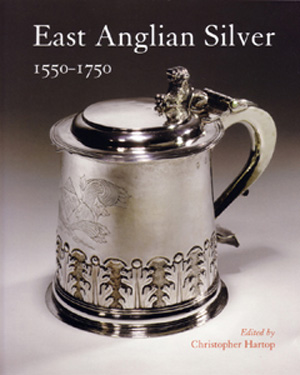1550-1750
edited by Christopher Hartop

|
Published by 128 pp.
10 3/8 × 8 11/16
in.
ISBN 978-0-9524322-2-7 |
|
Obtainable from any good bookseller or from: |
John Adamson: 90 Hertford Street, Cambridge CB4 3AQ, UK e-mail: Book orders |
|
Distributed in the United States and Canada by: |
ACC Art Books, New York |
|
SummaryThe beauty and stunning craftsmanship of silver
made in East Anglia have long been
celebrated by scholars and collectors. This book describes in depth a wealth of
important silver articles made in the region which are now to be found in museums
and private collections in Britain, America and Australia, as well as in churches
in Norfolk, Suffolk and Essex. Many of the objects featured have never been published
before, including a beaker in the Royal Collection by Elizabeth Haslewood, Norwich’s
only woman silversmith of the Stuart period, and a magnificent Charles II tankard
from the Gregory Peck collection.
The essays, the results of new research on many aspects of the economic and social
history of the region, set the silver in its historical context. They present a
fascinating perspective on everyday life for many East Anglians during the sixteenth
and seventeenth centuries. Even modest households might have owned a few silver spoons
at that time. The consumer demand from yeomen, merchants and others was filled by
silversmiths working not only in Norwich, the second largest city in the kingdom,
but also in smaller towns such as King’s Lynn, Great Yarmouth, Beccles, Ipswich,
Colchester and Cambridge.
Norwich closely guarded its right to mark silverware made in the city with its civic
arms. In the reign of Elizabeth, silversmiths there such as William Cobbold made
objects to equal the finest creations of London, Antwerp and Amsterdam. European
influences, especially from the Netherlands, were especially important in Norwich,
which had a large community of immigrant craftsmen during the sixteenth and
seventeenth centuries.
Nearly a hundred photographs of marks used by silversmiths throughout East Anglia,
many of them newly identified, make this book an essential tool for the collector
as well as the local historian.
|
‘... this is an excellent reference for dealers, collectors and silver historians.’ Antiques Trade Gazette
‘The book is lavishly illustrated, thoughtfully laid out and undoubtedly the most important book so far on the subject.’
Antique Silver Spoons
‘... a work of art in its own right.’ Ian Collins in Eastern Daily Press
‘... this must be reckoned the most important publication so far on the subject ... it is a “must” for anyone seriously interested in the subject ...’ The Finial
Christopher Hartop was born in Norfolk. His books include
The Huguenot Legacy (1996), Royal Goldsmiths: The Art of Rundell & Bridge (2005),
A Noble Feast (2008), The Classical Ideal (2010), A Noble Pursuit (2010) and
Norfolk Summer: Making The Go-Between (2011).
Mary Fewster taught history for twenty-seven years at the Hewett School, Norwich,
the last fifteen as head of the department. Brought up at Aldeburgh, she developed a
strong interest in local history from an early age. She completed an M.Phil. on the
Yarmouth herring industry for the University of East Anglia School of East Anglian Studies
and a Ph.D. on East Anglian goldsmiths 1500-1740 for the Department of History.
Christopher Garibaldi worked with English Heritage at Walmer Castle and Audley End
House and later catalogued the silver at Buckingham Palace and Windsor Castle as well as
that in the Speaker’s Residence at the House of Commons. From 1998 to 2003 he was
Assistant Keeper of Decorative Art at Norwich Castle Museum.
Philippa Glanville is an Associate Fellow of Warwick University. Recently retired as
Academic Director of Waddesdon Manor, the Rothschild Collection, she was Keeper of
Metalwork at the Victoria & Albert Museum 1989-99. Her books include Silver in England
(1987), Silver in Tudor and Early Stuart England (1990), and, with Gordon Glanville, a
chapter in City Merchants and the Arts (2004). She is a Fellow of the Society of
Antiquaries and was Chairman of the Silver Society 1988-9.
Brand Inglis first developed an interest in silver while at Westminster School and he
became a dealer in antique silver in 1962. He is the author of numerous publications
including The Arthur Negus Guide to British Silver (1980) and in 1972 he co-curated the
exhibition Lynn Silver, the catalogue of which remains a standard work. He was Chairman
of the Silver Society 1978-9.
Timothy Kent is a barrister and the author of many books on silver including London Silver Spoons and Their Makers 1500-1697 (1981),
West Country Silver Spoons and Their Makers 1550-1750 (1992) and Sussex Silver
and Its Makers (2002), as well as numerous papers in learned journals. He is a
Fellow of the Society of Antiquaries and was Chairman of the Silver Society 1977-8.
Colin Ticktum worked for the Treasury for over twenty-five years, where he was
successively Head of Finance and Senior Contracts Officer in Norwich. In 1986 he left
and started St Giles Silver, specializing in antique silver but especially spoons.
His own collection, comprising some five hundred examples, many of them East Anglian,
was published privately in 2001.
Wynyard Wilkinson, born in Nairobi, spent a large part of his life near East
Dereham, hence his natural interest in East Anglian silver. A dealer and published
researcher since his teens, he now lives south of Bury St Edmunds whose silversmiths
he has been researching during the last thirty years.
Contact the
publisher for further information:
e-mail: book enquiries,
letter: John Adamson, 90 Hertford Street, Cambridge
Please print off the order form and
send it by mail to John Adamson, 90 Hertford Street, Cambridge CB4 3AQ, England.
Contents
Reviews
Contributors
Enquiries
CB4 3AQ, England
How to order the book offline